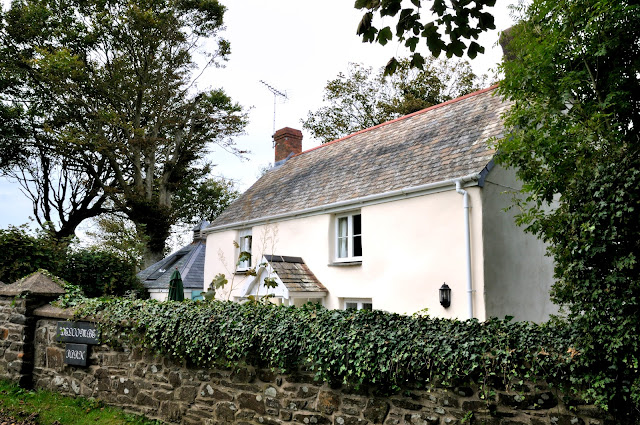Cornwall / Devon is a wonderful part of the UK. Amongst many others of course!. This holiday was to be with Matthew and Vicki plus their gorgeous son Adam. Welcombe was our destination - just inside Devon but right on the border with Cornwall.
Not far along the road from our holiday let was Welcombe Mouth Bay with its lovely waterfall crashing over the edge and running to the sea. Very picturesque! We had some lovely walks just from here.
Looking up the beach to the waterfall.
A good example of the rock strata further along the beach.
Another lovely spot not far away - Hartland Point .....
... this had a bigger waterfall called Wayefalls, and (below) a nearby camping spot - stunning!
If you are in this part of the world, you have to visit Clovelly. It has a harbour and is a tourist attraction notable for its steep pedestrianised cobbled main street, donkeys and views over the Bristol Channel. At the 2011 census, the parish population was 443, which was 50 fewer than ten years previously, according to Wikipedia.
Why would you leave your boat here?
A storm appeared to be brewing as we walked along the side of the harbour.
From the end of the sea wall, looking back to the steep incline which characterises this gorgeous village.
He might have had difficulty walking, but he was going to get his picture.
Looking back down the hill of Clovelly as we trudged back to the car.
One of the last places we visited, on the Friday, was the beautiful coastline of Morwenstow.
The eccentric, and reputedly opium-smoking, Reverend Robert Stephen Hawker (or Parson Hawker as he was known to his parishioners) lived here in the mid 1800s. Besides his normal clerical duties, he is renowned for having penned various stirring hymns and for keeping a watchful eye over ships travelling through these dangerous waters from the wooden hut he fashioned from driftwood. Hawker's Hut still perches precariously at the edge of one of the tallest cliffs in the area and is now owned by the National Trust - it is in fact their smallest property. Many a drowned sailor lies in an unmarked grave here, having been dragged up from the shore and given a Christian burial.
In September 1842 the Caledonia was homeward bound from Odessa, and called in at Falmouth to bury a crewman who had died of wounds suffered during a knife fight in Constantinople. The Caledonia then sailed for Gloucester to unload her cargo of wheat.
As she departed Falmouth a north-westerly gale was raging. At about 1 am on the morning of 8 September the ship's lookout saw waves breaking to leeward on Sharpnose Point, near Morwenstow, Cornwall.
Her captain, Stevenson Peter, shortened sail and tried to stand clear of the shore, but the ship refused to come up and soon hit the rocks at Sharpnose Point. As they hit, the captain ordered the crew to climb into the rigging, but the mast collapsed, throwing them into the sea where they all died. The sole survivor was Edward Le Dain from Jersey who managed to get ashore where a farmer discovered him at dawn. He was taken to the local Rectory where the Reverend Robert Stephen Hawker ensured that he was cared for and nursed back to health.
The bodies of the other crewmen eventually washed up on the beach and were buried in Morwenstow Churchyard. For some 162 years the white, carved pitch-pine figurehead of the brig was preserved in the churchyard as the headstone of the ship's captain and crew. During that time it was subjected to occasional minor repairs and countless layers of white paint. In 2004 it was found that the passage of time and the often harsh Atlantic weather had taken their toll, so it was removed for a prolonged drying out process, followed by scientific paint analysis and a major restoration. To fund this work, an appeal called The Caledonia Conservation Fund was launched by Morwenstow Parochial Church Council. The decision was made to mount the restored figurehead within the Church, and to create a more weather-resilient replica as the grave marker for the shipwrecked sailors. A service of dedication for the newly installed figurehead and grave marker was held at Morwenstow Parish Church on Sunday, 7 September 2008—the 166th anniversary of the tragedy. It was preceded by a brief act of commemoration held at the top cliff overlooking the shipwreck site, with a piper leading the way across the fields to the Church. The large congregation included nine descendants of Edward Le Dain (the lone survivor), two descendants of seaman Alexander Kent (one of the victims), several Hawker descendants, enthusiasts and scholars, and many local people and holidaymakers.
The original figurehead from the `Caledonia` is now on the wall in the church
Morwenstow church where Reverend Robert Stephen Hawker kept watch over his `flock`.
On the cliff face just below this spot is Hawker's hut where `Parson Hawker` kept a watchful eye over ships travelling through these dangerous waters
It was a bit misty when we arrived along the coast by Morwenstow. It is a beautiful coastline to walk along or to just stand and stare.




















No comments:
Post a Comment